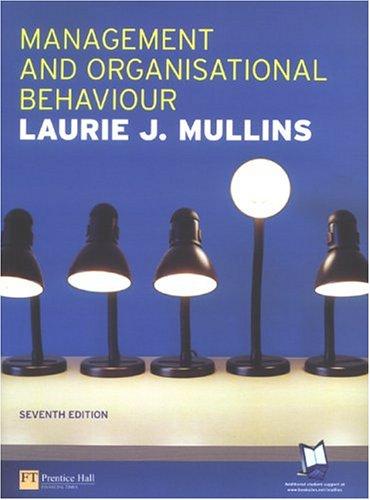Fabrique Dcor was established in the late 1980s by Freda and Brian Rickson when they were in
Question:
Fabrique Décor was established in the late 1980s by Freda and Brian Rickson when they were in their middle thirties and wanted a change from working in a large organisation. Mrs Rickson was essentially the ideas person, very creative with a flair for interpreting clients' requirements.
Mr Rickson's contribution to the business was as organiser of the practical workforce. This consisted of self-employed artisans and part-time tradesmen.
He also managed the purchase of materials and subcontract services such as curtain making.
The business was based in a suite of offices in a multi-purpose commercial building. No stocks of materials were held directly by Fabrique Décor. All materials were ordered to Freda Rickson's specifications and delivered to the client's site for the tradesmen to complete the work in line with Mrs Rickson's instructions.
In the early years this arrangement appeared to work well. The numbers of tradesmen were relatively small and most of them were known by Brian Rickson. He was able to keep check on the progress of each contract and Freda Rickson was equally able to monitor the quality of the work. She visited each site regularly to liaise with the clients to ensure that they were satisfied and to incorporate any changes the client may require.
The offices were staffed by three personnel.
Freda infrequently used her office, then mainly for initial discussions with clients. Most of the designing and planning was completed at the clients' premises with their active co-operation. Brian was more in evidence at the office suite, but of necessity, spent a great amount of time overseeing the various sites.
The three permanent staff at the offices were Mrs May Kemp (62), Miss Helen Goren (30) and Ms Tina Patch (25).
May Kemp had been with Freda ad Brian since the very early days of the business: she was totally capable of managing all the facets of the business.
She was also well able to cope with the idiosyncrasies of her two employers. Freda and Brian were very different characters. Freda had a mercurial temperament and Brian tended to be a bit laidback.
Too laid-back for Freda's liking, but May always seemed able to smooth things over.
May Kemp managed all the financial aspects of the business in association with an outside accountant who could be relied upon to appear when needed. It was May who paid suppliers and tradesmen and invoiced the clients. She checked purchase orders and delivery notes.
Delivery notes raised difficulties as she could only check against information given by tradesmen at the sites. When she had any doubts she was able to persuade Brian Rickson to physically check the situation at the site.
In all these responsibilities May was assisted by Tina Patch.
Helen Goren acted as receptionist when necessary, answered the telephone and assisted with general office duties.
Both Tina and Helen used the information technology facilities for word processing, accounting, payment of tradesmen and suppliers and invoicing.
As business activity increased so did the problems.
It became more and more difficult for Freda to give the personalised service to her clients. There were too many for her to visit with sufficient frequency to ensure client satisfaction.
Brian had similar difficulties in supervising the tradesmen working at so many sites. The days when he knew all those working at the various projects had long gone. The workforce was now drawn from a variety of sources, some less reliable than others.
It was becoming obvious to Brian that materials were being misappropriated. The records did not agree in some cases and May was getting very worried.
The quality of workmanship had declined in too many cases and Freda was angry. She accused Brian of a lack of interest in the business. They both started finding fault with the work of the office staff. Tina Patch started to use this state of affairs to undermine May Kemp. Tina saw herself in the role May occupied. In particular, she used client complaints to reinforce the pressure on May.
Eventually the situation came to a head and there was a tremendous row with everyone blaming the others. As the row was in full swing the accountant, Alison Lyle, arrived. At first she was taken by surprise, but quickly recovered. Having calmed everyone down she asked each of them to list the problems and suggest the causes. Alison said that they had descended into a 'blame culture' and had taken very little action to remedy the problems because they had failed to recognise the causes.
Alison went on to criticise the lack of development by Freda and Brian. The business was organised and staffed in much the same form as it was in the initial stages. They had not upgraded their IT or taken advantage of current developments.
She was very critical of Freda attempting to cover every new project. With the present volume of activity this was impractical and it was little wonder that they were running into trouble.
Questions
(a) The development of Fabrique Décor is at a crossroads. Discuss the organisational and financial implications of introducing a second interior designer.
(b) By adopting outsourcing as a practical approach to operating the business, Freda and Brian are exposed to considerable risk. Discuss those risks and describe how they may be minimised.
(c) Advise Freda and Brian on the ways in which the application of information technology could be updated.
(d) Following the accountant’s criticism of the organisation of Fabrique Décor, identify the problems and suggest the action needed to improve the situation.
Step by Step Answer:






